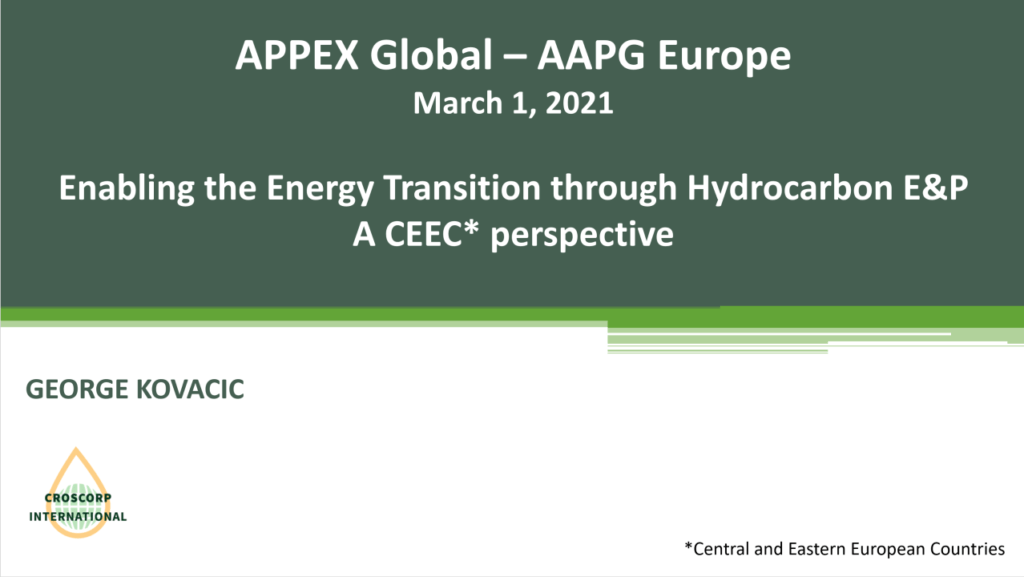Article by George Kovačić (original LinkedIn article can be found here)
The European Union has become center stage for one of the biggest global power struggles – the struggle over energy. Who will have access to reliable, efficient and a stable supply of energy as well as the lowest cost energy during the coming decades of energy transition? The stakes could not be higher. This struggle will determine whose industries and residents will prosper or falter. I predict the repercussions will be felt beyond the EU’s borders and significantly impact the future of the EU as well as NATO stability. The balance of power and sphere of influence could change in many countries bordering the EU and Russia yet, oddly, not much has been written about this power struggle.

On one side are the EU countries that have largely exhausted their domestic oil and gas reserves – Germany, Netherlands, Denmark, Italy and others. On the other side are the EU countries that have prolific hydrocarbon basins and yet have tremendous potential for new oil and gas discoveries and production – Romania, Poland, Greece, Bulgaria, Croatia and others. It pits the wealthy EU countries against their poorer EU peers where energy poverty often results in the use of high polluting coal and wood. It pits EU countries that have grown wealthy by exhausting their own oil and gas reserves against EU countries that are highly underexplored and have often just scratched their oil and gas potential. It pits EU countries that are increasingly dependent on oil and gas imports against EU countries where energy security is taken seriously. In some instances, it pits countries that were invaded and occupied by their neighbors both historically and recently against those same countries that suffered the repercussions of invasion and occupation. It pits Germany and Russia against Central and Southeastern European countries.

This power struggle can best be illustrated by outlining two competing visions of the EU energy transition. One vision is illustrated by the German-Russian alliance that is once again pressing ahead to complete their controversial Nord Stream 2 pipeline project. This project will deliver annually 55 billion m3 or 1.9 tcf of Russian natural gas to Germany. It will ensure for the Germans a new reliable, efficient and stable supply of natural gas as well as provide German industry and residents with the lowest cost new energy supply. Nord Stream 2 will help compensate for Germany’s costly energy transition failure – Energiewende – and still allow the Germans to phase out nuclear power plants while maintaining their position as EU’s economic powerhouse. But at what cost? The completion of Nord Stream 2 will make Germany and the EU more dependent on Russian energy. The pipeline will cement Russia’s energy dominance over the EU for decades to come. Meanwhile, it will provide Russia with billions of additional Euros annually and a huge energy influence over the EU. It will also provide Putin with an economic boost as well as show Russian citizens and their neighbors that Russia’s invasion and annexation of parts of Ukraine has no negative long-term consequence.
The other vision is illustrated by Central and Southeast European countries (CSEEC) that have an interest to explore and produce their own oil and gas potential. If successful, the CSEEC vision would increase EU’s energy security, reduce energy poverty as well as help reduce pollution and address climate change. A debate is ongoing in the European Commission that will determine if CSEEC will be allowed to derive the same benefits from hydrocarbons as their wealthy EU peers. The debate will determine if natural gas will be classified as a sustainable investment under EU green finance rules and if the applicable guidelines will be technologically feasible. In addition, I argue that EU’s EIB financing for oil and gas projects should be continued post 2021 and until the energy transition advances to a point that the EU no longer requires oil and gas imports. Within its borders, the EU has regulations and oversight that will ensure energy transition as well as progress towards carbon-neutral oil and gas production. The EU has no regulatory ability to ensure progress towards carbon-neutral oil and gas production from Russia, Africa, the Middle East and elsewhere. CSEEC’s vision provides for the region’s oil and gas production to replace imports. The result is increased energy security for the entire EU and reduced energy poverty.
A recent Deloitte study*, helps illustrate why the CSEEC vision is the best option for the EU. The study estimates that offshore Romanian oil and gas will create tens of thousands of jobs and contribute over 7 billion USD annually to the Romanian economy. I predict the economic impact and opportunities will be larger than outlined in the Deloitte study and will be multiplied many times throughout the region. With the economic spillover effects the opportunities that will be created will be substantial and allow the region to derive similar benefits from hydrocarbons as their wealthy EU peers. For example, a secure and less expensive natural gas feedstock will both stimulate the development of modern fertilizer facilities as well as hothouses which in turn will help make regional agricultural competitive on a global basis. The region is already blessed with a favorable climate, massive water reserves and substantial fertile soil. Meanwhile, the same secure and less expensive natural gas will encourage residents and industry to switch from more polluting fuels such as coal.
Meanwhile, countless examples from CSEEC illustrate why the region’s vision is best to reduce carbon emissions and pollution. CSEEC oil and gas will provide less polluting fuel to replace high polluting coal and wood. The jobs and revenue created from hydrocarbon exploration and production will lead to higher standard of living as well as more money to pay for more expensive less polluting energy. Today, poorer residents in Bosnia & Herzegovina individually dig and burn some of the highest polluting coal as it is the only fuel source they can afford. In Croatia, some homeowners that had damaged chimneys after recent earthquakes were continuing to use their fireplaces even though they were given free electric heaters as the cost of electricity was too expensive. At the same time, in areas of the region where gas has replaced wood for cooking and heating requirements, forests have regrown and now provide carbon sinks.
My recent AAPG presentation, “Enabling the Energy Transition through Hydrocarbon E&P”, available in the following video (Enabling Energy Transition through Hydrocarbon E&P – APPEX Global AAPG Presentation – March 1st, 2021 on Vimeo) and the corresponding slide deck (https://www.slideshare.net/GeorgeKovacic/aapg-europe-appex-global-presentation-by-george-kovacic-enabling-the-energy-transition-through-hydrocarbon-ep), further outlines how the energy transition can be enabled through regional hydrocarbon exploration and production. It outlines how CSEEC’s vision will provide energy security and wealth, reduce pollution and help in EU’s energy transition.
I look forward to your comments and discussion.
* The contribution of Black Sea oil & gas projects to the development of the Romanian economy (May 2018)
https://www2.deloitte.com/content/dam/Deloitte/ro/Documents/ImpRepOffshoreProjects_ENG.PDF



